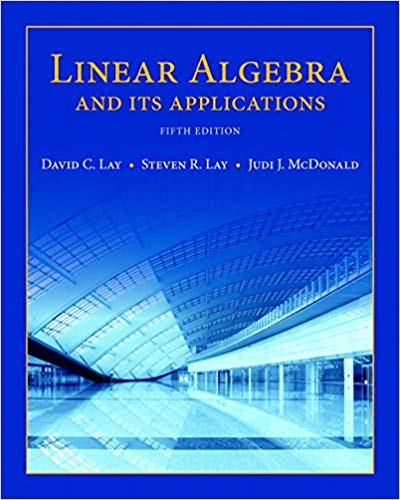
Linear Algebra and Its Applications, 5th Edition
Authors: David C. Lay, Steven R. Lay, Judi J. McDonald
ISBN-13: 978-0321982384
We have solutions for your book!
See our solution for Question 23E from Chapter 6.2 from Lay's Linear Algebra and Its Applications, 5th Edition.
Problem 23E
Chapter:
Problem:
In Exercises 23 and 24, all vectors are in Rn. Mark each statement True or False. Justify each answer. a. Not every linearly independent set in Rn is an orthogonal set. b. If y is a linear combination of nonzero vectors from an orthogonal set, then the weights in the linear combination can be computed without row operations on a matrix. c. If the vectors in an orthogonal set of nonzero vectors are normalized, then some of the new vectors may not be orthogonal. d. A matrix with orthonormal columns is an orthogonal matrix. e. IfLis a line through is the orthogonal projection of y onto L, then gives the distance from y to L.
Step-by-Step Solution
Given Information
We are given with some statements that we have to prove whether they are True or False.
Step-1: (a)
Check the example: \[ \mathbf { u } = \left[ \begin{array} { l } { 4 } \\ { 2 } \end{array} \right] \text { and } \mathbf { v } = \left[ \begin{array} { l } { 5 } \\ { 6 } \end{array} \right] \] Check for orthogonality: : \[{\bf{u}}{\bf{.v}} = 4 \times 5 + 2 \times 6 = 32\] The vectors are linearly independent, but not orthogonal.
The statement is True.
Step-2:(b)
The weights $c_1, c_2 .. c_n$ in any linear combination $\mathbf { y } = c _ { 1 } \mathbf { u } _ { 1 } + \cdots + c _ { p } \mathbf { u } _ { p }$ can be computed as: \[ c _ { j } = \dfrac { \mathbf { y } \cdot \mathbf { u } _ { j } } { \mathbf { u } _ { j } \cdot \mathbf { u } _ { j } } \] This does not involve any row-operations:
The statement is True.
Step-3:(c)
In an orthogonal set of nonzero vectors, if the vectors are normalized, the new vectors will be orthogonal as well as normal, and hence the new set will be an orthonormal set.
The statement is False
Step-4:(d)
By the definition of an orthogonal matrix has orthogonal columns and it is a square invertible matrix U such that \[ U ^ { - 1 } = U ^ { T } \] So the matrix must also be square
The statement is False
Step-5:(e)
The distance from $y$ to the line L, through the origin, is the length of the perpendicular line segment from $y$ to the orthogonal projection $\hat y$, that is, \[\left| {\left| {{\bf{y - \hat y}}} \right|} \right|\]
The statement is False
We are given with some statements that we have to prove whether they are True or False.
Step-1: (a)
Check the example: \[ \mathbf { u } = \left[ \begin{array} { l } { 4 } \\ { 2 } \end{array} \right] \text { and } \mathbf { v } = \left[ \begin{array} { l } { 5 } \\ { 6 } \end{array} \right] \] Check for orthogonality: : \[{\bf{u}}{\bf{.v}} = 4 \times 5 + 2 \times 6 = 32\] The vectors are linearly independent, but not orthogonal.
The statement is True.
Step-2:(b)
The weights $c_1, c_2 .. c_n$ in any linear combination $\mathbf { y } = c _ { 1 } \mathbf { u } _ { 1 } + \cdots + c _ { p } \mathbf { u } _ { p }$ can be computed as: \[ c _ { j } = \dfrac { \mathbf { y } \cdot \mathbf { u } _ { j } } { \mathbf { u } _ { j } \cdot \mathbf { u } _ { j } } \] This does not involve any row-operations:
The statement is True.
Step-3:(c)
In an orthogonal set of nonzero vectors, if the vectors are normalized, the new vectors will be orthogonal as well as normal, and hence the new set will be an orthonormal set.
The statement is False
Step-4:(d)
By the definition of an orthogonal matrix has orthogonal columns and it is a square invertible matrix U such that \[ U ^ { - 1 } = U ^ { T } \] So the matrix must also be square
The statement is False
Step-5:(e)
The distance from $y$ to the line L, through the origin, is the length of the perpendicular line segment from $y$ to the orthogonal projection $\hat y$, that is, \[\left| {\left| {{\bf{y - \hat y}}} \right|} \right|\]
The statement is False